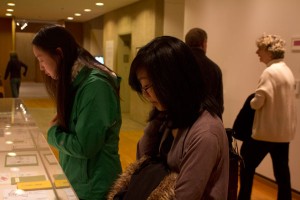Amid Cornell University’s classic, ivy-covered architecture, the distinctive lines of the Johnson Museum stick out. Inside, 33 international artists continue this powerful contrast through their exploration of the power of lines.
The boundary-shifting 1947 split of Pakistan from India, and later Bangladesh, inspired “Lines of Control,” an art exhibit of more than 40 works by international artists. The pieces range from profound to mundane. This diversity makes them mesh well in the way several lines can all combine into one thread.

“Lines of Control” displays the artistic gravity of solid, straight lines immediately. One of the first pieces in the upper gallery, Nadia Kaabi-Linke’s “All Along the Watchtower,” may initially confuse visitors. Identical shadows of huge hunting stands fall onto the wall and ground but the actual object is absent. The gravity of the idea and the large scale of the work are daunting and impressive.
The next three pieces show the role of lines and separation in nationalism. The diagonally titled flag “Untitled (There Is No Border Here)” by Shilpa Gupta consists of caution tape with the words “There is no border here” in place of “caution.” The tape pieces spell out several random phrases, like “I want to cut the world in half,” while creating stripes to fill out the flag. It sparks the question of whether there’s any logic behind patriotism.
Next to “Untitled” is “All Eyes Skywards During Annual Parade” by Rashid Rana. From a distance, the composition is a photograph of Pakistanis waving flags in celebration, wrapped across a corner of the museum. But up close, thousands of stills from popular 1980s films make up the image. Composing an overall nationalistic picture with many tiny movie stars famous to Indians and Pakistanis alike emphasizes the gap between these countries’ political and social realities. They still share commonalities, despite the polarizing issues concerning their borders.
The separation of India is not the only division inspiring the show. A piece by DAAR represents the Oslo Agreement between Palestine and Israel into many autonomous countries. “The Red Castle and the Lawless Line” features miniature models of opposing sets of stairs, the exterior of an industrial building, a theatre space and a tower atop a long wall. The five zigzags in the wall’s structure illustrate its dysfunction.
Most of the other artwork on display reflects similar broken promises and conflicts resulting from patriotic actions and nationalism. Several pieces include video projections to depict traumatic events from different conflicts. Both creative filmmaking and actual news footage show other countries, such as Palestine and Northern Ireland.
The exhibit also contains a few zany pieces on the lower level. “Home” by Sophie Ernst consists of interviews with four people drawing from memory the floor plans of their family’s former homes; these are projected onto three-dimensional Corian models constructed based on the interviews.
Across from “Trilogy,” “River/Disease” by Anita Dube draws every eye to its own collection. Glued onto the wall are plastic eyes, like the craft supplies, that form a river of vision. It shows the openness of lines rather than restriction, one of the few examples in the exhibit.
The final piece, “Global Kalea,” is a video of black type onto a white background. The transcription of a customer service phone conversation is meant to show the robotic nature of the interaction.
Whether there is anything between the lines of the conversation is unknown. The piece comes off more silly than profound, especially with the electronic
keyboard music playing behind the huge words.
“Lines of Control” shows how like people and nations, lines and artwork reflect whoever creates and controls them.




